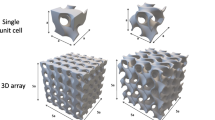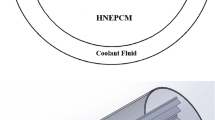Abstract
A problem of thermal ignition of an exothermic mixture with an inert filler in a thick‐walled container is formulated. It was found that synthesis can be performed under conditions of a weakly changing temperature if an inert filler is added to the mixture. Variation of critical conditions separating different thermal regimes with different values of model parameters is examined: ignition and extinction or ignition and slow transformation.
Similar content being viewed by others
REFERENCES
D. A. Frank-Kamenetskii, Diffusion and Heat Transfer in Chemical Kinetics [in Russian], Nauka, Moscow (1987).
K. G. Shkadinskii, N. I. Ozerkovskaya, and A. G. Merzhanov, “Postinduction processes during thermal explosion in the systems “porous material-reactive gas-solid product,” Combust. Expl. Shock Waves, 39, No. 2, 140–149 (2003).
V. V. Azatyan, I. A. Bolod'yan, Yu. N. Shebeko, and S. N. Kopylov, “Critical conditions of chain thermal explosion,” Combust. Expl. Shock Waves, 37, No. 5, 501–511 (2001).
V. I. Bykov and S. B. Tsybenova, “Parametric analysis of the simplest model of the theory of thermal explosion-the Zel'dovich-Semenov model,” Combust. Expl. Shock Waves, 37, No. 5, 523–534 (2001).
R. Sh. Gainutdinov, “Thermal explosion of a plate under boundary conditions of the second and third kinds,” Combust. Expl. Shock Waves, 37, No. 2, 187–189 (2001).
O. V. Lapshin and V. E. Ovcharenko, “A mathematical model of high-temperature synthesis of the intermetallic compound Ni3Al during ignition,” Combust. Expl. Shock Waves, 32, No. 2, 158–164 (1996).
O. V. Lapshin and V. E. Ovcharenko, “Effect of an inert filler on the ignition conditions of a powder mixture of nickel and aluminum,” Combust. Expl. Shock Waves, 34, No. 1, 26–28 (1998).
Yu. M. Grigor'ev, A. G. Merzhanov, and K. V. Pribytkova, “Critical conditions for thermal explosion in conductive heat transfer in the reacting zone and the surrounding medium,” Appl. Mech. Tech. Phys., No. 5, 10–14 (1966).
I. G. Dik, “Thermal-explosion degeneration limits in a system with an additional heat source,” Combust. Expl. Shock Waves, 16, No. 1, 126–128 (1980).
Author information
Authors and Affiliations
Rights and permissions
About this article
Cite this article
Knyazeva, A.G., Chashchina, A.A. Numerical Study of the Problem of Thermal Ignition in a Thick‐Walled Container. Combustion, Explosion, and Shock Waves 40, 432–437 (2004). https://doi.org/10.1023/B:CESW.0000033566.54441.e0
Issue Date:
DOI: https://doi.org/10.1023/B:CESW.0000033566.54441.e0




